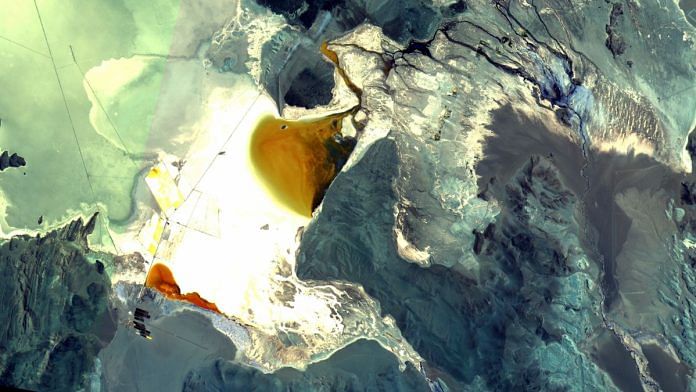New Delhi: There is a new wake-up call for critical mineral mining in the world, especially lithium mining. A study, conducted by scientists at the University of Massachusetts Amherst (UMass) to gauge how much freshwater is available on the Earth for lithium mining, has found that it is far lesser than what was initially imagined.
The study was published Wednesday in the journal Communications Earth and Environment.
Lithium, one of the most important minerals for renewable energy, electric vehicles, and solar panels, is found on the Earth in pools of brine water (highly concentrated solution of salt) known as lagoons. A lot of freshwater is required for the processing of lithium. Most of the Earth’s lithium comes from countries such as Chile, Argentina, and Bolivia—together known as the Lithium Triangle.
The UMass hydrologists analysed the amount of freshwater that was entering the lithium lagoons in 28 basins in this Lithium Triangle, and found it to be shockingly lower than what was initially estimated. Mainstream estimates say it is between 90 and 230 millimetres per year, but the researchers found it to be close to two to 30 millimetres per year.
As part of the research, they studied the topography of water basins in the Lithium Triangle, and also estimated the water being used by local communities in the region.
The only way to ensure a sustainable division of the resources would be for communities, scientists and the lithium mining industry to work together, the study said.
Also Read: Search for an Indian Carl Sagan is on. Science influencers are being trained in labs and likes
Drug for rare disease makes human blood toxic to mosquitoes
A new study has found that a rare disease drug known as nitisinone, when ingested, makes human blood toxic to mosquitoes. The study, conducted by researchers at the University of Notre Dame in the United States, was published Wednesday. The researchers were searching for drugs that would help curb the spread of malaria. One of the known methods to do so is by making human and animal blood toxic to mosquitoes. Until now, there was only one common drug that could achieve this— ivermectin.
The problem with ivermectin is that it is toxic to the environment, and when used frequently, there is a tendency for people to develop a resistance to it. This is where nitisinone comes in. It is a drug mainly used to treat a rare disease where the body is unable to process an amino acid called tyrosine.
The researchers discovered that the drug also has an effect on mosquito bodies, causing them to die quickly. Nitisinone also lasts longer than ivermectin in the human body and needs fewer doses.
Getting zapped by lightning is good for some trees
A new study in the journal New Phytologist discusses certain tree species found in the Bahamas that can not only survive lightning strikes but survive better in such conditions because they help reduce a number of parasitic infestations on the trees. During their research in the Barro Colorado Nature Monument in central Panama, the authors found that while most trees were damaged and almost killed in lightning, some remained the same with little to no damage. Published Wednesday, the study is a collaboration between US and Bahamian scientists.
One such species is Dipteryx oleifera, also known as the eboe tree. While lightning killed most of their neighbouring trees, these eboes subsequently looked taller and received more light and nutrients. The researchers also found that the eboe trees lost 78 percent of parasitic infestations and vines after lightning strikes, making them healthier.
The study authors are now looking to understand whether these trees have any specific traits that allow them to survive and thrive in electrical lightning strikes.
Galapagos birds are more aggressive due to traffic noises
A study in the journal Animal Behaviour has found that Galapagos yellow warbler birds, which are exposed to more human traffic noises compared to other birds, are more aggressive than others. The Galapagos islands in Ecuador are considered a haven for exotic bird and animal species, and a place where even Charles Darwin was inspired to work on evolution.
Researchers from Austria and the UK conducted experiments wherein they exposed these yellow songbirds to recorded traffic noises and found that the ones who lived closer to these noises were more aggressive than the ones who were not. Yellow warblers were considered to be aggressive when they repeatedly kept approaching the speaker, seeming disturbed by it, and flew around it considerably.
More importantly, the birds also changed their songs—their distinctive animal calls—in accordance with the sound coming from the traffic, showing how human actions, however minimal, can have effects on animal behaviour.
(Edited by Radifah Kabir)
Also Read: Posture panic hits researchers. IITs, AIIMS, big hospitals use smart microscopes now






